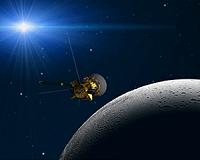 |
Pasadena CA (SPX) Dec 01, 2010 New images and data from NASA's Cassini spacecraft give scientists a unique Saturn-lit view of active fissures through the south polar region of Saturn's moon Enceladus. They reveal a more complicated web of warm fractures than previously thought. Scientists working jointly with Cassini's composite infrared spectrometer and its high-resolution imaging camera have constructed the highest-resolution heat intensity maps yet of the hottest part of a region of long fissures spraying water vapor and icy particles from Enceladus. These fissures have been nicknamed "tiger stripes." Additional high-resolution spectrometer maps of one end of the tiger stripes Alexandria Sulcus and Cairo Sulcus reveal never-before-seen warm fractures that branch off like split ends from the main tiger stripe trenches. They also show an intriguing warm spot isolated from other active surface fissures. "The ends of the tiger stripes may be the places where the activity is just getting started, or is winding down, so the complex patterns of heat we see there may give us clues to the life cycle of tiger stripes," said John Spencer, a Cassini team scientist based at Southwest Research Institute in Boulder, Colo. The images and maps come from the Aug. 13, 2010, Enceladus flyby, Cassini's last remote sensing flyby of the moon until 2015. The geometry of the many flybys between now and 2015 will not allow Cassini to do thermal scans like these, because the spacecraft will be too close to scan the surface and will not view the south pole. This Enceladus flyby, the 11th of Cassini's tour, also gave Cassini its last look at any part of the active south polar region in sunlight. The highest-resolution spectrometer scan examined the hottest part of the entire tiger stripe system, part of the fracture called Damascus Sulcus. Scientists used the scan to measure fracture temperatures up to190 Kelvin (minus 120 degrees Fahrenheit). This temperature appears slightly higher than previously measured temperatures at Damascus, which were around 170 Kelvin (minus 150 degrees Fahrenheit). Spencer said he isn't sure if this tiger stripe is just more active than it was the last time Cassini's spectrometer scanned it, in 2008, or if the hottest part of the tiger stripe is so narrow that previous scans averaged its temperature out over a larger area. In any case, the new scan had such good resolution, showing details as small as 800 meters (2,600 feet), that scientists could see for the first time warm material flanking the central trench of Damascus, cooling off quickly away from the trench. The Damascus thermal scan also shows large variations in heat output within a few kilometers along the length of the fracture. This unprecedented resolution will help scientists understand how the tiger stripes deliver heat to the surface of Enceladus. Cassini acquired the thermal map of Damascus simultaneously with a visible-light image where the tiger stripe is lit by sunlight reflecting off Saturn. The visible-light and thermal data were merged to help scientists understand the relationships between physical heat processes and surface geology. "Our high-resolution images show that this section of Damascus Sulcus is among the most structurally complex and tectonically dynamic of the tiger stripes," said imaging science team associate Paul Helfenstein of Cornell University, Ithaca, N.Y. Some details in the appearance of the landforms, such as a peculiar pattern of curving striations along the flanks of Damascus, had not previously been noticed in ordinary sunlit images. The day after the Enceladus flyby, Cassini swooped by the icy moon Tethys, collecting images that helped fill in gaps in the Tethys global map. Cassini's new views of the heavily cratered moon will help scientists understand how tectonic forces, impact cratering, and perhaps even ancient resurfacing events have shaped the moon's appearance. The Cassini-Huygens mission is a cooperative project of NASA, the European Space Agency and the Italian Space Agency. The Jet Propulsion Laboratory, a division of the California Institute of Technology in Pasadena, manages the mission for NASA's Science Mission Directorate, Washington. The Cassini orbiter and its two onboard cameras were designed, developed and assembled at JPL. The imaging operations center is based at the Space Science Institute in Boulder, Colo. The composite infrared spectrometer team is based at NASA's Goddard Space Flight Center, Greenbelt, Md., where the instrument was built.
Share This Article With Planet Earth
Related Links Cassini-Huygens mission Explore The Ring World of Saturn and her moons Jupiter and its Moons The million outer planets of a star called Sol News Flash at Mercury
 Cassini Back To Normal, Ready For Enceladus
Cassini Back To Normal, Ready For EnceladusPasadena CA (JPL) Nov 30, 2010 NASA's Cassini spacecraft resumed normal operations Nov. 24. All science instruments have been turned back on, the spacecraft is properly configured and Cassini is in good health. Mission managers expect to get a full stream of data during next week's flyby of the Saturnian moon Enceladus. Cassini went into safe mode on Nov. 2, when one bit flipped in the onboard command and data sub ... read more |
|
| The content herein, unless otherwise known to be public domain, are Copyright 1995-2010 - SpaceDaily. AFP and UPI Wire Stories are copyright Agence France-Presse and United Press International. ESA Portal Reports are copyright European Space Agency. All NASA sourced material is public domain. Additional copyrights may apply in whole or part to other bona fide parties. Advertising does not imply endorsement,agreement or approval of any opinions, statements or information provided by SpaceDaily on any Web page published or hosted by SpaceDaily. Privacy Statement |